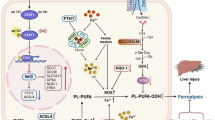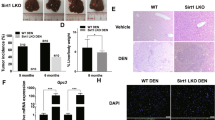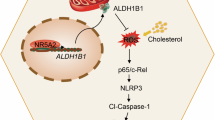Abstract
Toosendanin (TSN) is the main active compound in Toosendan Fructus and Meliae Cortex, two commonly used traditional Chinese medicines. TSN has been reported to induce hepatotoxicity, but its mechanism remains unclear. In this study, we demonstrated the critical role of nuclear factor erythroid 2-related factor 2 (Nrf2) in protecting against TSN-induced hepatotoxicity in mice and human normal liver L-02 cells. In mice, administration of TSN (10 mg/kg)-induced acute liver injury evidenced by increased serum alanine/aspartate aminotransferase (ALT/AST) and alkaline phosphatase (ALP) activities, and total bilirubin (TBiL) content as well as the histological changes. Furthermore, TSN markedly increased liver reactive oxygen species (ROS) and malondialdehyde (MDA) levels, and decreased liver glutathione (GSH) content and Nrf2 expression. In L-02 cells, TSN (2 μM) time-dependently reduced glutamate-cysteine ligase (GCL) activity and cellular expression of the catalytic/modify subunit of GCL (GCLC/GCLM). Moreover, TSN reduced cellular GSH content and the increased ROS formation, and time-dependently decreased Nrf2 expression and increased the expression of the Nrf2 inhibitor protein kelch-like ECH-associated protein-1 (Keap1). Pre-administration of quercetin (40, 80 mg/kg) effectively inhibited TSN-induced liver oxidative injury and reversed the decreased expression of Nrf2 and GCLC/GCLM in vivo and in vitro. In addition, the quercetin-provided protection against TSN-induced hepatotoxicity was diminished in Nrf2 knock-out mice. In conclusion, TSN decreases cellular GSH content by reducing Nrf2-mediated GCLC/GCLM expression via decreasing Nrf2 expression. Quercetin attenuates TSN-induced hepatotoxicity by inducing the Nrf2/GCL/GSH antioxidant signaling pathway. This study implies that inducing Nrf2 activation may be an effective strategy to prevent TSN-induced hepatotoxicity.
Similar content being viewed by others
Log in or create a free account to read this content
Gain free access to this article, as well as selected content from this journal and more on nature.com
or
References
Ma X, Peng JH, Hu YY. Chinese herbal medicine-induced liver injury. J Clin Transl Hepatol. 2014;2:170–5.
Bunchomtavakul C, Reddy K. Review article: herbal and dietary supplement hepatotoxicity. Aliment Pharmacol Ther. 2013;37:3–17.
Teo DC, Ng PS, Tan SH, Lim AT, Toh DS, Chan SY, et al. Drug-induced liver injury associated with complementary and alternative medicine: a review of adverse event reports in an Asian community from 2009 to 2014. BMC Complement Altern Med. 2016;16:192.
Zhang P, Ye YG, Yang XZ, Jiao YT. Systematic review on Chinese herbal medicine induced liver injury. Evid Based Complement Altern Med. 2016;2016:3560812.
Chinese Pharmacopoeia Commission. Pharmacopeia of the people’s republic of China (2015) version. Beijing: The Medicine Science and Technology Press of China; 2015. p. 203.
Shi YL, Li MF. Biological effects of toosendanin, a triterpenoid extracted from Chinese traditional medicine. Prog Neurobiol. 2007;82:1–10.
Zhang T, Li J, Yin F, Lin B, Wang Z, Xu J, et al. Toosendanin demonstrates promising anti-tumor efficacy in osteosarcoma by targeting STAT3. Oncogene. 2017;36:6627–39.
Li X, You M, Liu YJ, Ma L, Jin PP, Zhou R, et al. Reversal of the apoptotic resistance of non-small-cell lung carcinoma towards TRAIL by natural product Toosendanin. Sci Rep. 2017;7:42748.
Cao L, Qu D, Wang H, Zhang S, Jia C, Shi Z, et al. Toosendanin exerts an anti-cancer effect in glioblastoma by inducing estrogen receptor β- and p53-mediated apoptosis. Int J Mol Sci. 2016;17:E1928.
Wang G, Feng CC, Chu SJ, Zhang R, Lu YM, Zhu JS, et al. Toosendanin inhibits growth and induces apoptosis in colorectal cancer cells through suppression of AKT/GSK-3β/β-catenin pathway. Int J Oncol. 2015;47:1767–74.
He Y, Wang J, Liu X, Zhang L, Yi G, Li C, et al. Toosendanin inhibits hepatocellular carcinoma cells by inducing mitochondria-dependent apoptosis. Planta Med. 2010;76:1447–53.
Xu H, Zhang JL. Natural products-based insecticidal agents 9. Design, semisynthesis and insecticidal activity of 28-acyloxy derivatives of toosendanin against Mythimna separata Walker in vivo. Bioorg Med Chem Lett. 2011;21:1974–7.
Zhang J, Qu H, Yu X, Zhi X, Chen H, Xu H. Combinatorial synthesis of a series of alkyl/alkenylacyloxy derivatives at the C-28 position of toosendanin as insecticidal agents. Comb Chem High Throughput Screen. 2013;16:394–9.
Zhang YH, Qi XM, Gong LK, Li Y, Liu LL, Xue X, et al. Roles of reactive oxygen species and MAP kinases in the primary rat hepatocytes death induced by toosendanin. Toxicology. 2008;249:62–8.
Lu X, Ji C, Tong W, Lian X, Wu Y, Fan X, et al. Integrated analysis of microRNA and mRNA expression profiles highlights the complex and dynamic behavior of toosendanin-induced liver injury in mice. Sci Rep. 2016;6:34225.
Kaspar JW, Niture SK, Jaiswal AK. Nrf2:INrf2 (Keap1) signaling in oxidative stress. Free Radic Biol Med. 2009;47:1304–9.
Klaassen CD, Reisman SA. Nrf2 the rescue: effects of the antioxidative/electrophilic response in the liver. Toxicol Appl Pharmacol. 2010;244:57–65.
Bataille AM, Manautou JE. Nrf2: A potential target for new therapeutics in liver disease. Clin Pharmacol Ther. 2012;92:340–8.
Jadeja RN, Upadhyay KK, Devkar RV, Khurana S. Naturally occurring Nrf2 activators: potential in treatment of liver injury. Oxid Med Cell Longev. 2016;2016:3453926.
Boots AW, Haenan GRMM, Bast A. Health effects of quercetin: from antioxidant to nutraceutical. Eur J Pharmacol. 2008;585:325–37.
Ji LL, Ma YB, Wang ZY, Cai ZX, Pang C, Wang ZT. Quercetin prevents pyrrolizidine alkaloid clivorine-induced liver injury in mice by elevating body defense capacity. PLoS ONE. 2014;9:e98970.
Liu CM, Zheng GH, Ming QL, Sun JM, Cheng C. Protective effect of quercetin on lead-induced oxidative stress and endoplasmic reticulum stress in rat liver via the IRE1/JNK and PI3K/Akt pathway. Free Radic Res. 2013;47:192–201.
Liu CM, Ma JQ, Xie WR, Liu SS, Feng ZJ, Zheng GH, et al. Quercetin protects mouse liver against nickel-induced DNA methylation and inflammation associated with the Nrf2/HO-1 and p38/STAT1/NF-κB pathway. Food Chem Toxicol. 2015;82:19–26.
Peng Z, Gong X, Yang Y, Huang L, Zhang Q, Zhang P, et al. Hepatoprotective effect of quercetin against LPS/d-GalN induced acute liver injury in mice by inhibiting the IKK/NF-κB and MAPK signal pathways. Int Immunopharmacol. 2017;52:281–9.
Wei CB, Tao K, Jiang R, Zhou LD, Zhang QH, Yuan CS. Quercetin protects mouse liver against triptolide-induced hepatic injury by restoring Th17/Treg balance through Tim-3 and TLR4-MyD88-NF-κB pathway. Int Immunopharmacol. 2017;53:73–82.
Kemelo MK, Pierzynova A, Kutinova Canova N, Kucera T, Farqhali H. The involvement of sirtuin 1 and heme oxygenase 1 in the hepatoprotective effects of quercetin against carbon tetrachloride-induced sub-chronic liver toxicity in rats. Chem Biol Interact. 2017;269:1–8.
Ji LL, Sheng YC, Zheng ZY, Shi L, Wang ZT. The involvement of p62-Keap1-Nrf2 antioxidative signaling pathway and JNK in the protection of natural flavonoid quercetin against hepatotoxicity. Free Radic Biol Med. 2015;85:12–23.
Domitrovic R, Jakovac H, Vasiljev Marchesi V, Vladimir-knezevic S, Cvijanovia O, Tadic Z, et al. Differential hepatoprotective mechanisms of rutin and quercetin in CCl(4)-intoxicated BALB/cN mice. Acta Pharmacol Sin. 2012;33:1260–70.
Wen CJ, Chen MJ, Yeh CT, Yen GC. Hepatoprotection of quercetin against oxidative stress by induction of metallothionein expression through activating MAPK and PI3K pathways and enhancing Nrf2 DNA-binding activity. N Biotechnol. 2011;28:767–77.
Pang C, Zheng ZY, Shi L, Sheng YC, Wei H, Wang ZT, et al. Caffeic acid prevents acetaminophen-induced liver injury by activating the Keap1-Nrf2 antioxidative defense system. Free Radic Biol Med. 2016;91:236–46.
Liang QN, Sheng YC, Jiang P, Ji LL, Xia YY, Min Y, et al. The gender-dependent difference of liver GSH antioxidant system in mice and its influence on isoline-induced liver injury. Toxicology. 2011;280:61–9.
Griffith OW. Mechanism of action, metabolism and toxicity of buthionine sulfoximine and its higher homologs, potent inhibitors of glutathione synthesis. J Biol Chem. 1982;257:13704–12.
Kelly GS. Clinical applications of N-acetylcysteine. Altern Med Rev. 1998;3:114–27.
Lu SC. Glutathione synthesis. Biochim Biophys Acta. 2013;1830:3143–53.
Ju J, Qi Z, Cai X, Cao P, Huang Y, Wang S, et al. The apoptotic effects of toosendanin are partially mediated by activation of deoxycytidine kinase in HL-60 cells. PLoS ONE. 2012;7:e52536.
Zhang B, Wang ZF, Tang MZ, Shi YL. Growth inhibition and apoptosis-induced effect on human cancer cells of toosendanin, a triterpenoid derivative from Chinese traditional medicine. Invest New Drugs. 2005;23:547–53.
DeLeve LD, Kaplowitz N. Glutathione metabolism and its role in hepatotoxicity. Pharmacol Ther. 1991;52:287–305.
Komatsu M, Kurokawa H, Waguri S, Taguchi K, Kobayashi A, Ichimura Y, et al. The selective autophagy substrate p62 activates the stress responsive transcription factor Nrf2 through inactivation of Keap1. Nat Cell Biol. 2010;12:213–23.
Zhou N, Yang Q, Yang M, Zhang DQ, Jiang B, Li XZ. Simultaneous determination of rutin, isoquercitrin and quercetin contents in Fructus Toosendan by HPLC. Chin J Pharm Anal. 2013;2:225–9.
Tewari D, Nabavi SF, Nabavi SM, Sureda A, Farooqi AA, Atanasov AG, et al. Targeting activator protein 1 signaling pathway by bioactive natural agents: possible therapeutic strategy for cancer prevention and intervention. Pharmacol Res. 2017;128:366–75.
Kashyap D, Mittal S, Sak K, Sinqhal P, Tuli HS. Molecular mechanisms of action of quercetin in cancer: recent advances. Tumour Biol. 2016;37:12927–39.
Khan F, Niaz K, Maqbool F, Ismail Hassan F, Abdollahi M, Nagulapalli Venkata KC, et al. Molecular targets underlying the anticancer effects of quercetin: an update. Nutrients. 2016;8:529.
Acknowledgements
This work was financially supported by the State Major Science and Technology Special Projects during the 12th Five-year Plan (2015ZX09501004-002-002) and the National Natural Science Foundation of China (81322053, 81573679).
Author contributions
YJ and L-lJ conceived and designed the experiments; YJ, Z-lH, LL, and YY performed the experiments; YJ and Z-lH analyzed the data; C-hW and Z-tW contributed new reagents; L-lJ wrote the manuscript.
Author information
Authors and Affiliations
Corresponding author
Ethics declarations
Competing interests
The authors declare no competing interests.
Additional information
Publisher's note: Springer Nature remains neutral with regard to jurisdictional claims in published maps and institutional affiliations.
Electronic supplementary material
Rights and permissions
About this article
Cite this article
Jin, Y., Huang, Zl., Li, L. et al. Quercetin attenuates toosendanin-induced hepatotoxicity through inducing the Nrf2/GCL/GSH antioxidant signaling pathway. Acta Pharmacol Sin 40, 75–85 (2019). https://doi.org/10.1038/s41401-018-0024-8
Received:
Accepted:
Published:
Issue date:
DOI: https://doi.org/10.1038/s41401-018-0024-8
Keywords
This article is cited by
-
The protective effects of propolis against lipopolysaccharide-induced acute liver injury by modulating serum metabolites and gut flora
Scientific Reports (2025)
-
Flavonoids from Polygonum hydropiper L. regulate PCV2-induced oxidative stress of RAW264.7 cells via Pi3k/AKT and Nrf2/HO-1 signaling pathways
Scientific Reports (2025)
-
Metabolites Identification of Two Novel Chemical Constituents From Melia. Toosendan Sieb.et Zucc. in Rats by UPLC/ESI/qTOF-MS Analysis
Chromatographia (2025)
-
Azithromycin ameliorated cigarette smoke-induced airway epithelial barrier dysfunction by activating Nrf2/GCL/GSH signaling pathway
Respiratory Research (2023)
-
Self-Assembled Maslinic Acid Attenuates Doxorobucin Induced Cytotoxicity via Nrf2 Signaling Pathway: An In Vitro and In Silico Study in Human Healthy Cells
Cell Biochemistry and Biophysics (2022)



